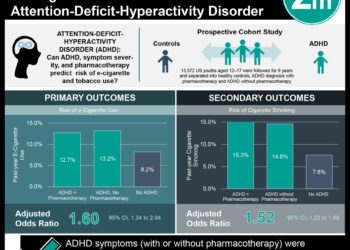ADHD stimulant treatment associated with changes in BMI trajectory
Image: PD/CDC/ Debora Cartagena
1. Among adolescents, unmedicated childhood attention-deficit/hyperactivity disorder (ADHD) was associated with faster BMI growth after age 10 when compared to those undiagnosed with ADHD and without stimulant treatment.
2. ADHD stimulant treatment was associated with slower rates of BMI growth in childhood, faster growth in adolescence, and elevated BMI as an adolescent.
Evidence Rating Level: 2 (Good)
Study Rundown: Attention-deficit/hyperactivity disorder (ADHD) is a commonly diagnosed psychiatric disorder among pediatric patients that is often treated with stimulant medication. Previous research has indicated a potential link between ADHD and growth deficits as well as obesity. In the current study, researchers sought to further investigate the potential association between ADHD diagnosis, stimulant-treated ADHD, and timing/duration of stimulant use with childhood BMI trajectories. Results indicated that a diagnosis of ADHD alone was associated with more rapid increases in BMI after the age of 10. Stimulant use, compared to other ADHD treatments, was linked to slower growth in childhood but accelerated growth and increased BMI in late adolescence. Earlier age of stimulant use and longer stimulant treatment duration were associated with greater effects on BMI. Despite this study’s large sample size, its homogenous white population limits generalizability to a racially diverse population. Taking into account this possible link, physicians should be mindful of the medications that they prescribe to patients with ADHD and also be prepared to initiate interventions if BMI approaches unhealthy ranges.
Click to read the study, published today in Pediatrics
Relevant Reading: Overweight in children and adolescents in relation to attention-deficit/hyperactivity disorder
In-Depth [retrospective cohort study]: A total of 163 820 (50% male, 91% white, mean age = 9 years) files from pediatric patients ages 3-18 years old were examined from the Geisinger Health System, a primary healthcare system in central and northeastern Pennsylvania. Sociodemographics, vital signs, laboratory values, procedures, and medications of each patient were extracted from medical records. Linear regression models were used to evaluate childhood BMI trajectories with respect to ADHD diagnosis, stimulant use, age of first stimulant use, and duration of stimulant use. Children with an ADHD diagnosis and stimulant use grew slower in childhood but more rapidly in adolescence (p < 0.0001). Children with an ADHD diagnosis and without stimulant use displayed rapid BMI growth after 10 years of age (p < 0.0001) compared with controls (children without an ADHD diagnosis or stimulant use). Earlier age of stimulant use and longer duration stimulant use independently associated with significantly slower initial BMI growth in childhood and increased growth in adolescence when compared to controls.
More from this author: Current BMI standards may be predictive of metabolic syndrome, Increased cognitive activity post-concussion associated with prolonged symptom duration, Early adiposity rebound associated with worse metabolic markers, Dramatic rise of gun violence seen in PG-13 movies, Increased sleep linked to lower dietary intake in children
©2012-2014 2minutemedicine.com. All rights reserved. No works may be reproduced without expressed written consent from 2minutemedicine.com. Disclaimer: We present factual information directly from peer reviewed medical journals. No post should be construed as medical advice and is not intended as such by the authors, editors, staff or by 2minutemedicine.com. PLEASE SEE A HEALTHCARE PROVIDER IN YOUR AREA IF YOU SEEK MEDICAL ADVICE OF ANY SORT.









